This page is dedicated to articles, images and videos about actions in defense of public education against the corporate neoliberal agenda of cuts, privatization and more.
___________________________________________________________
Students protest education in Argentine capital
By DEBORA REYThe Associated Press
Thursday, September 16, 2010; 9:46 PM
BUENOS AIRES, Argentina -- Thousands of young Argentines marched to the presidential palace on Thursday to protest the quality of public education, joining a student rebellion that accuses politicians of neglecting schools and universities that were once the envy of Latin America.
High schoolers have occupied about 30 public schools in Buenos Aires to protest their deteriorating conditions. The takeovers later spread to public universities, with students occupying a half dozen, this week, teachers joined the rebellion, putting 700,000 students out of school.
Students carrying a giant model of a pencil on their shoulders like a coffin and crosses symbolizing the death of public education on Thursday marched from Argentina's Congress to the presidential palace. They cite abysmal conditions in schools, including a lack of heating gas, poor electrical systems, leaky ceilings and broken windows, among other problems.
"For a long time, years, decades, a policy of cutting funding to public education has been carried out and this policy has reached such an extreme that the conditions needed to study almost do not exist," said Itai Hagman, president of the Buenos Aires University Federation.
Early in the 20th century, Argentina had a public education system considered a model for Latin America that assured most citizens access to free schooling. But that system came under fire during Argentina's dictatorship and was later subjected to financing cuts under market-oriented democratic governments.
Thursday's march coincided with the 34th anniversary of the "Night of the Pencils" remembering a group of high school students who were abducted and killed during the 1976-1983 dictatorship.
The protesters' ire is directed at conservative Buenos Aires Mayor Mauricio Macri, who handles high school financing, and center-left President Cristina Fernandez, whose government administers public universities.
"Our recent governments have not paid attention to public education. We want that to change," said Agustina Scattolini, 20, who is one of the students occupying a Buenos Aires high school for almost two weeks.
Buenos Aires' Education Ministry says that only 100 of the city's 1,200 schools have budget problems and that its education budget for 2010 is the highest in the last eight years.
The federal government says it spends 6.45 percent of GDP on public education, one of the highest figures in recent decades.
In both cases, however, most of the money is spent on teacher salaries and not on infrastructure.
"Unfortunately we have been very patient over the years, but out patience is over. We want practical solutions," said Hagman.
Parents and Students Occupy Whittier School Fieldhouse in Chicago
Sat Sep 18 2010, by Yana Kunichoff
from Gapers Block - a Chicago publication
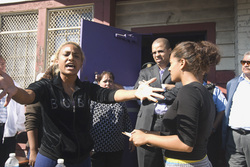 Several dozen parents and students completed the third night of an occupation of a Pilsen elementary field house Friday night, protesting the planned demolition of the allegedly dilapidated structure. The sit-in has withstood several visits by the police - at one point they threatened arrests then abruptly left after more than 100 students, parents and community members pushed past barricades to support the protesters - and scored the promise of an interview with Ron Huberman to discuss turning the field house into a library for the school.
Several dozen parents and students completed the third night of an occupation of a Pilsen elementary field house Friday night, protesting the planned demolition of the allegedly dilapidated structure. The sit-in has withstood several visits by the police - at one point they threatened arrests then abruptly left after more than 100 students, parents and community members pushed past barricades to support the protesters - and scored the promise of an interview with Ron Huberman to discuss turning the field house into a library for the school. 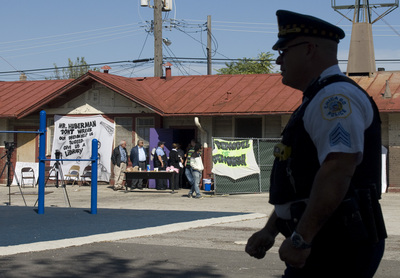
The field house of Whittier Dual Language School, at 1900 W. 23rd St., has been used as a center for after-school programs and community meetings. According to Gema Gaete, an activists with Teachers for Social Justice and Pilsen resident, parents found out that the building was set to be demolished in November 2009, when a budget detailing the proposed spending of Tax Increment Financing (TIF) money allotted to Whittier was released.
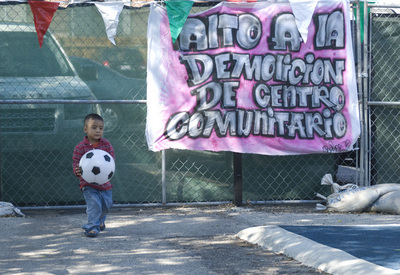
The itemized budget allocated $356,000 to tear down the field house, Gaete said, and started a call from parents to "repolish, not demolish." Community members hired their own engineer, who Gaete said determined that the building could be salvaged with minimal investment.
CPS spokeswoman Monique Bond said the district lacked the money to renovate the building. "(With) the budgetary constraints we are under, nothing is going to happen," Bond said. "That building has to come down."
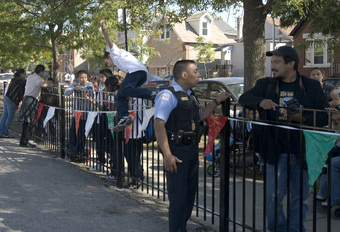
The protest has so far seen a couple of iconic moves from CPS - a locksmith came and changed the locks on the field house as parents and students gathered inside, and shortly after the protest began a sign was put up in English and Spanish saying that the building was unsafe for occupancy. After this sign was removed by protesters, CPS security officers put up another sign saying "Off Limits: Do Not Enter" by order of the City of Chicago Inspector.
Anastacia, the mother of two Whittier students and one Whittier graduate, said that it was essential for the school to have an extra library. Speaking with bloodshot eyes filled with tears, Anastacia, who asked that her last name not be used for fear of arrest, said that the teachers required students to do research, but many of the classroom libraries are not sufficient, and many students do not have access to computers.
Despite the threats of arrest and sleepless nights, Anastacia said the fight was worth it because "we're gaining what we want."
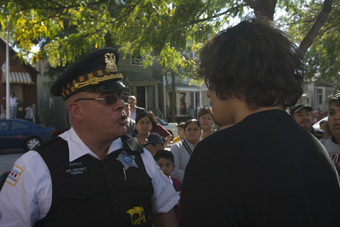
School activism in Chicago has a history of direct actions - in 2001, activists and parents in Little Village went on a hunger strike to revive a forgotten promise for a new school in their high-density neighborhood. Eventually, the city put a $5 million down payment for what would eventually become the Little Village Lawndale High School, also known as the Social Justice High School.
Whether the Whittier parents will have a similar success remains to be seen, but meanwhile the occupation continues.
Yana Kunichoff is a fellow at Truthout.org. Photos by Sarah Goke/Creation Cinema
— Mechanics
In New Jersey, a Civics Lesson in the Internet Age

Ruth Fremson/The New York Times
In Newark, students took their protest to City Hall, but the real target of their message was Gov. Christopher J. Christie, who has cut state aid to schools.
By WINNIE HU
Published: April 27, 2010
It was a silent call to arms: an easy-to-overlook message urging New Jersey students to take a stand against the budget cuts that threaten class sizes and choices as well as after-school activities. But some 18,000 students accepted the invitation posted last month on Facebook, the social media site better known for publicizing parties and sporting events. And on Tuesday many of them — and many others — walked out of class in one of the largest grass-roots demonstrations to hit New Jersey in years.The protest disrupted classroom routines and standardized testing in some of the state’s biggest and best-known school districts, offering a real-life civics lesson that unfolded on lawns, sidewalks, parking lots and football fields.
The mass walkouts were inspired by Michelle Ryan Lauto, an 18-year-old aspiring actress and a college freshman, and came a week after voters rejected 58 percent of school district budgets put to a vote across the state (not all districts have a direct budget vote).
“All I did was make a Facebook page,” said Ms. Lauto, who graduated last year from Northern Valley Regional High School in Old Tappan, N.J. “Anyone who has an opinion could do that and have their opinion heard. I would love to see kids in high school step up and start their own protests and change things in their own way.”
At Columbia High School in Maplewood, that looked like 200 students marching around the building waving signs reading “We are the future” and “We love our teachers.”
In West Orange, a district that is considering laying off 84 employees, reducing busing, cutting back on music and art, and dropping sports teams, it was high school students rallying in the football stands.At Montclair High School, it meant nearly half of the 1,900 students gathered outside the school in the morning, with some chanting, “No more budget cuts.”
In the largest showing, thousands of high school students in Newark marched past honking cars stuck in midday traffic to fill the steps of City Hall under the watchful gaze of dozens of police officers. With their protests, the students sought to send a message to Gov. Christopher J. Christie, a Republican whose reductions in state aid to education had led many districts to cut staff and programs and to ask for larger-than-usual property tax increases. Mr. Christie, who has taken on the state’s largest teachers’ union in his efforts to close an $11 billion deficit, has proposed reducing direct aid to nearly 600 districts by an amount equal to up to 5 percent of each district’s operating budget.
“It feels like he is taking money from us, and we’re already poor,” said Johanna Pagan, 16, a sophomore at West Side High School in Newark, who feared her school would lose teachers and extracurricular programs because of the governor’s cuts. “The schools here have bad reputations, and we need aid and we need programs to develop.”
Michael Drewniak, the governor’s press secretary, released a statement on Tuesday saying that students belonged in the classroom. “It is also our firm hope that the students were motivated by youthful rebellion or spring fever,” Mr. Drewniak said, “and not by encouragement from any one-sided view of the current budget crisis in New Jersey.”
Bret D. Schundler, the education commissioner, also urged schools to enforce attendance policies and not let students walk out of class. State education officials said they had a call from one district that had moved students taking standardized tests to another part of the building because of potential noise.
Not every school had students walk out. Nancy Dries, a spokeswoman for the top-ranked Millburn district, which has used surplus money to avoid major cuts, said it was “business as usual” there.
But in many other places, students came to school ready to make a political statement. Emma Wolin, a junior at Columbia High, walked out of second-period Spanish with several classmates, even though the school had warned that they would face detention.
“It’s the activities and school spirit that make Columbia a great school, and I want to keep it that way,” she said. Judy Levy, a spokeswoman for the South Orange and Maplewood district, said that teachers did mark protesting students absent, and that some students went back and forth between the walkout and their classes, while others chose not to participate because their classes were reviewing for Advanced Placement exams that begin on Monday.
Ms. Lauto, whose message inspired the walkouts, said in an interview that she was amazed and gratified that so many students had responded. She said the state education cuts had really hit home because her mother and sister both work in public schools in Hudson County.
Ms. Lauto, enrolled at Pace University, said she has always had an activist streak. In seventh grade, she tried — but failed — to organize a protest over a new dress code, and after President George W. Bush was re-elected in 2004, she wrote “Going to Canada, Be Back in 4 Years” on a T-shirt and wore it to class.
But until now, Ms. Lauto said, she has used Facebook only to keep in touch with friends and let them know when she is performing in shows. She alerted those 600 Facebook friends to her message calling for a student walkout and asked them to pass it on.
Within a week, Ms. Lauto received hundreds of responses, not all of them positive. In fact, so many students insulted her and said the walkout was a stupid idea that she disabled the message function on her Facebook page. On Tuesday, Ms. Lauto joined students who walked out of High Tech High School in Bergen County. She said she was not planning any more protests, but hoped that students learned that their voices could be heard.
“I made this page with the best of intentions,” she said. “The fact that it has become so wildly successful — I’m so overwhelmed.”
This article has been revised to reflect the following correction:
Correction: May 1, 2010
An article and a picture caption on Wednesday about protests by students in New Jersey over cuts in state aid to education misidentified the county in which High Tech High School, one site of the protests, is located. It is in Hudson County, not Bergen.
Correction: May 1, 2010
An article and a picture caption on Wednesday about protests by students in New Jersey over cuts in state aid to education misidentified the county in which High Tech High School, one site of the protests, is located. It is in Hudson County, not Bergen.



